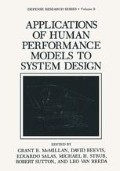Abstract
Two areas of digital simulation are particularly relevant to valid system performance during predesign: mission modelling and man-machine modelling. In this paper, the latter technique is emphasized. The architecture (including the artificial intelligence components) and validation data for a particular model are presented. The components of the predesign process are illustrated in Fig. 1. This process has evolved from, and been applied to a variety of weapons systems (cf. Refs. 1, 2 & 3) and documents (for example, Refs. 4, 5 & 6).
Access this chapter
Tax calculation will be finalised at checkout
Purchases are for personal use only
Preview
Unable to display preview. Download preview PDF.
References
Taylor, R.R. and Poole, E.R., A Mission Oriented Approach to Cockpit Design as Applied to Observation and Attack Helicopters, American Helicopter Society 40th Annual Forum, Arlington, VA, May 1984.
Holley, C.D. and Parks, R.E., Predicting Man-Machine System Performance in Predesign, Bell Helicopter, Textron, 1987.
Graf, V.A. and Holley, C.D., Human Factors Impact on the V-22 Osprey Cockpit Development: An Overview, American Helicopter Society, Washington, D.C., June 1988.
Human Engineering Requirements for Measurement of Operator Workload, ADS-30, U.S. Army Research and Technology Laboratories (AVSCOM), St. Louis, MO, November 1986.
O’Donnell, R.D. and Eggemeir, T., Workload Assessment Methodology, “Handbook of Perception and Human Performance;’ Vol. 2, Cognitive Processes in Performance, K.R. Boff, L. Kaufman and J.P. Thomas (eds), Wiley, New York, NY, 1986.
Human Engineering Design Criteria for Military Systems, Equipment, and Facilities, MIL-STD-1472C, Department of Defence, May 1981.
Sticha, P.J., Analytical Models of Performance of Procedure, IEEE, 0547–3578/84/0000–0841, 1984.
Campbell, D.T. and Stanley, J.C., “Experimental and Quasi-Experimental Designs for Research;’ McNally, Chicago, IL, 1966.
Sequitur’s Workload Analysis System (SWAS): User’s Manual, Sequitur Systems, Fort Worth, TX, 1986.
Karger, D.W. and Bayha, F.H.,“Engineered Work Measurement;’ Industrial Press, New York, NY, 1966.
Generic Data System, Methods Time Measurement ( MTM) Association, Fair Lawn, NJ, 1987.
Siegel, A.I. and Wolf, J.J.,“Man-Machine Simulation Models;’ Wiley, New York NY, 1969.
Wickens, D.C., Processing Resources in Attention, “Varieties of Attention;’ R. Parasuraman and R. Davies (eds), Academic Press, New York, NY, 1984.
Wickens, D.C., The Structure of Attentional Resources,“Attention and Performance VIII;’ R. Nickerson and R. Pew (eds), Erlbaum, Hillsdale, NJ, 1980.
Wickens, D.C., Mountford, S.J. and Schreiner, W.S., Multiple Resources, Task-Hemispheric Integrity, and Individual Differences in Time-Sharing Efficiency, Human Factors 23, 1981.
Multidimensional Scaling of Task Relationships, Sequitur Working Papers, Sequitur Systems, Fort Worth, TX, 1985.
Carroll, J. and Chang, J., Analysis of Individual Differences in Multidimensional Scaling via an N-way Generalization of Eckart-Young Decomposition, Psychometrika 35, 1970.
Derrick, W.L., The Relationship Between Processing Resource and Subjective Dimensions of Operator Workload, “Human Factor Society 25th Annual Meeting, Proceedings,” 1981.
Advanced Rotorcraft Technology Integration: Interim Report, BHTI Report 677–099–02, Bell Helicopter, Fort Worth, TX, May 1986.
Advanced Rotorcraft Technology Integration: Flight Test Report, BHTI Report 677–099–026, Bell Helicopter, Fort Worth, TX, August 1986.
Author information
Authors and Affiliations
Editor information
Editors and Affiliations
Rights and permissions
Copyright information
© 1989 Springer Science+Business Media New York
About this chapter
Cite this chapter
Holley, C.D. (1989). A Model for Performing System Performance Analysis in Predesign. In: McMillan, G.R., Beevis, D., Salas, E., Strub, M.H., Sutton, R., Van Breda, L. (eds) Applications of Human Performance Models to System Design. Springer, Boston, MA. https://doi.org/10.1007/978-1-4757-9244-7_7
Download citation
DOI: https://doi.org/10.1007/978-1-4757-9244-7_7
Publisher Name: Springer, Boston, MA
Print ISBN: 978-1-4757-9246-1
Online ISBN: 978-1-4757-9244-7
eBook Packages: Springer Book Archive

